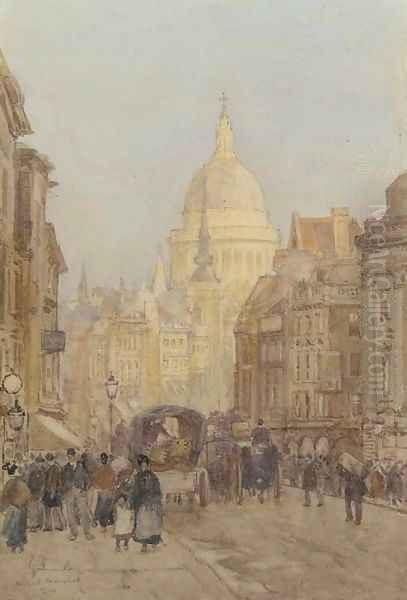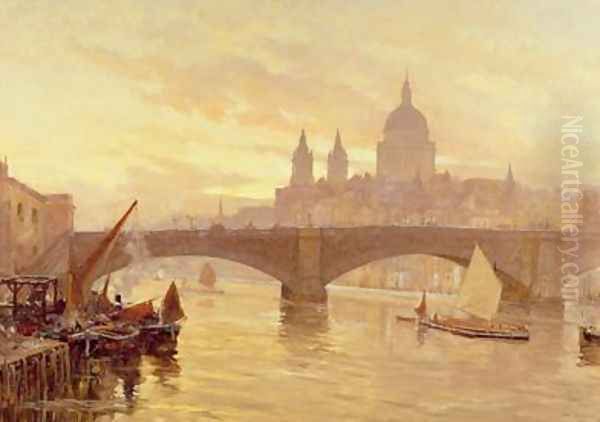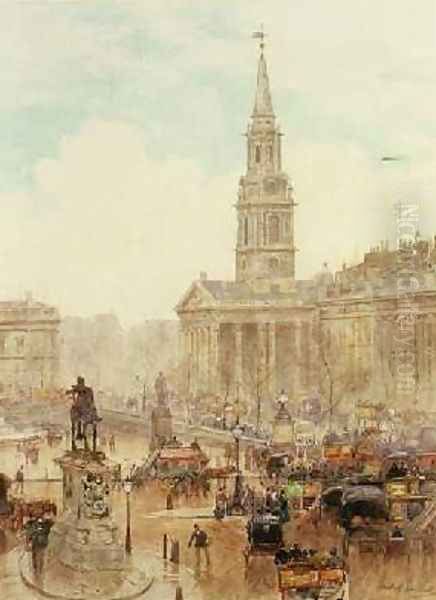Herbert Menzies Marshall stands as a significant, if sometimes overlooked, figure in the annals of British art, particularly renowned for his evocative watercolour depictions of London at the turn of the 20th century. His work captures the unique atmosphere, architectural grandeur, and bustling life of a city undergoing profound transformation. As an artist, he combined meticulous observation with a romantic sensibility, leaving behind a legacy of images that are both historical documents and works of considerable artistic merit.
Early Life and Artistic Formation
Born in Leeds in 1841, Herbert Menzies Marshall's journey into the world of art was not immediate. He initially pursued a different academic path, attending Westminster School and subsequently Trinity College, Cambridge, where he studied mathematics. This early grounding in a discipline requiring precision and analytical thought perhaps subtly informed his later artistic approach, particularly his attention to architectural detail.
Following his university education, Marshall's interests shifted towards architecture. He traveled to Paris to study under the notable French architect Charles-Auguste Questel, a figure associated with the Beaux-Arts tradition. This architectural training provided him with an invaluable understanding of form, structure, and perspective, skills that would become hallmarks of his later paintings. Upon his return to England, he further honed his skills at the Royal Academy Schools in London, a premier institution for artistic training in Britain. For a time, he practiced as an architect, but his passion increasingly gravitated towards painting, specifically the medium of watercolour.
The Allure of Watercolour and Urban Landscapes
Watercolour painting held a distinguished position in British art, with a lineage stretching back to artists like Paul Sandby, Thomas Girtin, and the incomparable J.M.W. Turner. By the Victorian era, it was a highly respected medium, capable of capturing both intimate details and broad atmospheric effects. Marshall was drawn to its translucency and immediacy, qualities well-suited to depicting the fleeting light and mood of urban environments.

While some of his contemporaries, like Myles Birket Foster or Helen Allingham, focused on idyllic rural scenes and cottage life, Marshall found his primary muse in the sprawling metropolis of London. He was not alone in this fascination; artists like James McNeill Whistler were contemporaneously exploring the atmospheric poetry of the Thames and London nights, albeit with a more impressionistic and tonal approach. Marshall’s work, however, often retained a greater degree of topographical accuracy, even as he imbued his scenes with a distinct mood.
His decision to focus on urban landscapes, particularly those of London, placed him in a tradition that included earlier artists like Canaletto, who famously painted London views in the 18th century, and later, figures such as Samuel Scott. However, Marshall's London was the London of the late Victorian and Edwardian periods – a city of horse-drawn omnibuses, gas lamps, and the ever-present London fog, which he masterfully rendered.
Artistic Style and Technique
Herbert Menzies Marshall's style is characterized by a delicate balance between detailed representation and atmospheric evocation. His architectural training is evident in the confident rendering of buildings, from the grand facades of St. Paul's Cathedral and Westminster Abbey to the more modest structures lining the city's thoroughfares. He possessed a keen eye for perspective and an ability to convey the scale and complexity of urban spaces.
A defining feature of his work is his treatment of light and atmosphere. Marshall was particularly adept at capturing the soft, diffused light of an overcast London day, the smoky haze of industrial London, or the ethereal glow of twilight. His depictions of fog are particularly noteworthy, transforming familiar landmarks into mysterious, almost dreamlike apparitions. This interest in atmospheric effects aligns him with a broader late 19th-century artistic concern, seen in the works of Impressionists and Tonalists, though Marshall’s approach remained rooted in a more traditional representational framework.
His palette was often subtle, employing a range of greys, blues, and muted earth tones to convey the city's characteristic ambiance. However, he could also introduce touches of brighter colour to highlight specific details – the red of a bus, the warm glow from a shop window, or the varied hues of a bustling market. His brushwork was typically controlled and precise, allowing for a high degree of detail without sacrificing the overall unity of the composition.
London as the Protagonist: Key Themes and Subjects
For Marshall, London was more than just a backdrop; it was the central character in his artistic narrative. He explored various facets of the city, from its iconic landmarks and grand public spaces to its quieter, more intimate corners.

His views often captured the dynamism of the city. Streets teem with activity: pedestrians hurry along pavements, horse-drawn carriages and omnibuses navigate the thoroughfares, and vendors ply their trades. Works depicting areas like Fleet Street, Trafalgar Square, or Piccadilly Circus showcase this vibrant urban energy. He was interested in the flow of life, the daily rhythms of the metropolis.
Architectural monuments feature prominently. St. Paul's Cathedral, viewed from different angles and under varying light conditions, was a recurring subject. Westminster Abbey, the Houses of Parliament, and the Tower of London also appeared frequently, rendered with an appreciation for their historical significance and architectural majesty. Unlike the purely topographical artists of earlier generations, Marshall often sought to capture these buildings as integral parts of a living city, enveloped by its unique atmosphere.
The River Thames was another significant theme. He painted numerous views along the river, capturing its bridges, wharves, and the constant traffic of boats and barges. These scenes often highlight the interplay of water, sky, and the city's skyline, showcasing his skill in rendering reflections and atmospheric perspective.
Representative Works
Several works stand out as representative of Herbert Menzies Marshall's oeuvre and artistic concerns.
Fleet Street looking towards St. Paul's is one of his most iconic images. This painting masterfully captures the bustling atmosphere of one of London's most famous streets, with the majestic dome of St. Paul's Cathedral rising in the distance, often softened by the city's haze. The composition typically draws the viewer's eye down the busy thoroughfare, populated with figures and vehicles, conveying both the grandeur of the architecture and the vibrancy of daily life. The interplay of light and shadow, and the subtle gradations of tone used to depict the atmospheric conditions, are characteristic of Marshall's skill.
Southwark Bridge is another significant work. Bridges were a popular subject for artists depicting London, offering dynamic compositional possibilities and symbolizing connection and passage. Marshall’s depictions of Southwark Bridge, or other Thames bridges, would often emphasize the structure's engineering against the backdrop of the city and the river's activity. He would pay close attention to the atmospheric conditions, perhaps a misty morning or a dusky evening, lending a poetic quality to the scene. The date range often cited for a version of Southwark Bridge is between 1841 (his birth year) and 1913 (his death year), indicating it was a subject he likely returned to or a prominent piece from his mature period.

Other typical subjects included views of Whitehall, The Strand, Cheapside, and various market scenes. He also painted views in other cities, including some in France and Holland, where the influence of Dutch Old Masters like Jan van der Heyden or Johannes Vermeer (in terms of light and urban composition) might be discerned in his meticulous approach to cityscapes.
Exhibitions, Recognition, and Affiliations
Herbert Menzies Marshall achieved considerable recognition during his lifetime. He exhibited regularly at prestigious venues, including the Royal Academy, a key institution for any artist seeking to establish a reputation in Britain. His participation in Royal Academy exhibitions signifies that his work met the standards of the leading art establishment of the day.
He was an active member of the Royal Watercolour Society (RWS), being elected an Associate in 1879 and a full member in 1883. The RWS (originally the Society of Painters in Water Colours) was, and remains, a vital organization for promoting the medium. His involvement underscores his commitment to watercolour and his standing among its leading practitioners. Contemporaries in the RWS would have included artists like Sir Lawrence Alma-Tadema (though more known for oils, he also worked in watercolour) and Walter Langley of the Newlyn School.
Marshall was also a member of the Royal Society of Painter-Etchers and Engravers (RE), indicating his proficiency in printmaking techniques as well. Etching, like watercolour, allowed for fine detail and atmospheric effects, and many artists of the period, including Whistler and Sir Frank Short, excelled in this medium. One of Marshall's etchings, Turle’s House, Westminster, is held in the collection of the Reading Public Museum, acquired by purchase, demonstrating the institutional recognition of his work.
His works were also shown at other venues such as the Fine Art Society, a commercial gallery that played an important role in the London art world. The fact that his works were exhibited and collected by public institutions like the Reading Public Museum, and are likely held in other collections such as the Victoria and Albert Museum and the British Museum (which have extensive holdings of British watercolours and prints), attests to his contemporary and lasting significance. Modern exhibitions, such as those at commercial galleries like Chris Beetles Gallery in London, which specializes in British watercolours, continue to feature his work, bringing it to new audiences.
There is also a mention of his involvement in designing a concert invitation for the Royal College of Music, possibly alongside other noted artists of the day such as George du Maurier (the writer and illustrator) and Hubert von Herkomer (a versatile artist proficient in painting, printmaking, and even early filmmaking and musical composition). This suggests Marshall was well-connected within London's broader artistic and cultural circles.
Contemporaries and Artistic Milieu
To fully appreciate Herbert Menzies Marshall's contribution, it is useful to consider him within the context of his contemporaries. The late Victorian and Edwardian art world was diverse and dynamic. While the Pre-Raphaelites had made their mark earlier, their influence lingered. The Aesthetic Movement, championed by figures like Whistler and Albert Moore, emphasized "art for art's sake." Impressionism, though slower to gain traction in Britain than in France, was also beginning to influence younger artists.
Marshall’s work can be seen as occupying a space between traditional topographical painting and more atmospheric, impressionistic approaches. He was less radical than Whistler in his dissolution of form, yet more focused on mood and atmosphere than purely documentary artists.
He shared an interest in London subjects with artists like the French émigré James Tissot, who painted scenes of London society, and later, Walter Sickert and the Camden Town Group, who would explore more gritty, everyday aspects of urban life. However, Marshall’s London is generally more picturesque and less concerned with social commentary than the work of Sickert.
His dedication to watercolour aligns him with a strong British tradition. Artists like Rose Barton, an Irish contemporary, also specialized in watercolour views of London and other cities, often with a similarly atmospheric and charming quality. Albert Goodwin was another contemporary watercolourist known for his imaginative and atmospheric landscapes, sometimes depicting urban scenes with a Turneresque grandeur. The illustrative tradition was also strong, with artists like Hugh Thomson and Arthur Rackham creating popular works, though their focus was different from Marshall's.
Legacy and Conclusion
Herbert Menzies Marshall passed away in London in 1913. He left behind a substantial body of work that serves as a valuable visual record of London at a specific moment in its history. His paintings evoke the character and atmosphere of the late Victorian and Edwardian metropolis with a sensitivity and skill that continue to appeal to collectors and art enthusiasts.
His contribution lies in his ability to elevate topographical accuracy with an artist's eye for light, mood, and composition. He captured not just the physical appearance of London, but something of its soul – its grandeur, its energy, and its often-misty charm. While perhaps not as revolutionary as some of his contemporaries, Marshall was a master of his chosen medium and a dedicated chronicler of the city he clearly loved.
His works are more than just historical documents; they are carefully crafted artistic statements that demonstrate the enduring appeal of watercolour and the timeless fascination of the urban landscape. For those interested in the history of London, British watercolour painting, or simply evocative cityscapes, the art of Herbert Menzies Marshall offers a rich and rewarding field of study. His paintings invite us to step back in time and experience the unique ambiance of a bygone London, seen through the eyes of a skilled and sensitive observer.